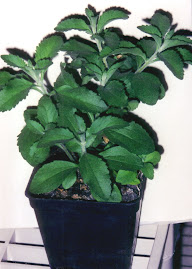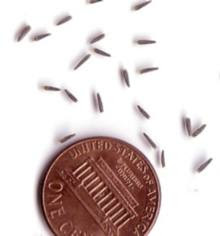
Following is the Introduction from Growing and Using Stevia: The Sweet Leaf from Garden to Table with 35 Recipes.
The leaves of Stevia rebaudiana are much sweeter than common sugar. No wonder it’s sometimes called “sweet leaf” in Paraguay and Brazil where it originated. Stevia leaves, though, are low-glycemic, low-calorie,[1] and do not encourage dental cavities.[2] All this makes stevia a great natural alternative to sugar and artificial sweeteners.
Stevia does not taste exactly like sugar. It has a unique flavor; much like honey or maple syrup have their own flavors—especially in the case of whole green stevia. Most people find the taste pleasant when the proper amount is used to make tea or combined with compatible ingredients.
The Problem with Refined Sugar
Why avoid sugar? It’s OK in moderation, but refined sugar adds lots of calories to the diet without contributing significant amounts of nutrients. The average American diet includes so many of these empty calories, there’s little room for needed nutrients. This can lead to malnutrition and obesity. A 2005 Penn State study found the average U.S. preschooler gets 14–17 teaspoons of added sugar per day![3] Twelve percent of the 4 and 5 year-olds surveyed got more than 25% of their calories from added sugar. These children also had the lowest consumption of most nutrients. They didn’t get enough grains, vegetables, fruits, and other nutrient-rich foods. Another issue with refined sugar, white flour, and other foods with a high glycemic index is that they enter the blood stream quickly, leading to rapid fluctuations in blood sugar levels. Finally, too much sugar can encourage tooth decay and more time at the dentist’s office.
What About Artificial Sweeteners?
Artificial sweeteners have drawbacks as well. Aspartame, for instance, should not be used in cooking. When heated, it breaks down into its constituent parts. Additionally, aspartame has been a major cause of health related complaints to the FDA (U.S. Food and Drug Administration).[4] Stevia, on the other hand, has not prompted reports of health problems despite being used in large quantities since the 1970’s in countries such as Japan.[5]
Order your copy of Growing and Using Stevia: The Sweet Leaf from Garden to Table with 35 Recipes through one of these links:
directly from Prairie Oak Publishing
from Amazon.com.
Notes
[1] A 2004 study confirmed stevia leaf is lower in calories than aspartame, much sweeter than sucrose, and has a lower glycemic index as compared to sucrose: S.M. Savita and others, 2004 “Stevia rebaudiana—A Functional Component for Food Industry,” Journal of Human Ecology 15 (4): 261-264.
[2] A University Of Illinois College Of Dentistry study found that neither Stevioside nor Rebaudioside A (the main sweet glycosides in stevia) was cariogenic (promoting of dental cavities) under the conditions of the study. S. A. Das and others. 1992. "Evaluation of the Cariogenic Potential of the Intense Natural Sweeteners Stevioside and Rebaudioside A". Caries Research. 26 (5): 363.
[3] S. Kranz, H. Smiciklas-Wright, A. M. Siega-Riz, and D. Mitchell. 2005. "Adverse Effect of High Added Sugar Consumption on Dietary Intake in American Preschoolers," Journal of Pediatrics 146 (1): 105-111.
[4] cf. Centers for Disease Control (CDC). 1984. "Evaluation of consumer complaints related to aspartame use". MMWR. Morbidity and Mortality Weekly Report. 33 (43): 605-7.
[5] cf. Daniel Mowery, Ph.D., Life with Stevia: How Sweet it is! 1992. Available online: http://healthfree.com/stevlife.html
###
The leaves of Stevia rebaudiana are much sweeter than common sugar. No wonder it’s sometimes called “sweet leaf” in Paraguay and Brazil where it originated. Stevia leaves, though, are low-glycemic, low-calorie,[1] and do not encourage dental cavities.[2] All this makes stevia a great natural alternative to sugar and artificial sweeteners.
Stevia does not taste exactly like sugar. It has a unique flavor; much like honey or maple syrup have their own flavors—especially in the case of whole green stevia. Most people find the taste pleasant when the proper amount is used to make tea or combined with compatible ingredients.
The Problem with Refined Sugar
Why avoid sugar? It’s OK in moderation, but refined sugar adds lots of calories to the diet without contributing significant amounts of nutrients. The average American diet includes so many of these empty calories, there’s little room for needed nutrients. This can lead to malnutrition and obesity. A 2005 Penn State study found the average U.S. preschooler gets 14–17 teaspoons of added sugar per day![3] Twelve percent of the 4 and 5 year-olds surveyed got more than 25% of their calories from added sugar. These children also had the lowest consumption of most nutrients. They didn’t get enough grains, vegetables, fruits, and other nutrient-rich foods. Another issue with refined sugar, white flour, and other foods with a high glycemic index is that they enter the blood stream quickly, leading to rapid fluctuations in blood sugar levels. Finally, too much sugar can encourage tooth decay and more time at the dentist’s office.
What About Artificial Sweeteners?
Artificial sweeteners have drawbacks as well. Aspartame, for instance, should not be used in cooking. When heated, it breaks down into its constituent parts. Additionally, aspartame has been a major cause of health related complaints to the FDA (U.S. Food and Drug Administration).[4] Stevia, on the other hand, has not prompted reports of health problems despite being used in large quantities since the 1970’s in countries such as Japan.[5]
Order your copy of Growing and Using Stevia: The Sweet Leaf from Garden to Table with 35 Recipes through one of these links:
directly from Prairie Oak Publishing
from Amazon.com.
Notes
[1] A 2004 study confirmed stevia leaf is lower in calories than aspartame, much sweeter than sucrose, and has a lower glycemic index as compared to sucrose: S.M. Savita and others, 2004 “Stevia rebaudiana—A Functional Component for Food Industry,” Journal of Human Ecology 15 (4): 261-264.
[2] A University Of Illinois College Of Dentistry study found that neither Stevioside nor Rebaudioside A (the main sweet glycosides in stevia) was cariogenic (promoting of dental cavities) under the conditions of the study. S. A. Das and others. 1992. "Evaluation of the Cariogenic Potential of the Intense Natural Sweeteners Stevioside and Rebaudioside A". Caries Research. 26 (5): 363.
[3] S. Kranz, H. Smiciklas-Wright, A. M. Siega-Riz, and D. Mitchell. 2005. "Adverse Effect of High Added Sugar Consumption on Dietary Intake in American Preschoolers," Journal of Pediatrics 146 (1): 105-111.
[4] cf. Centers for Disease Control (CDC). 1984. "Evaluation of consumer complaints related to aspartame use". MMWR. Morbidity and Mortality Weekly Report. 33 (43): 605-7.
[5] cf. Daniel Mowery, Ph.D., Life with Stevia: How Sweet it is! 1992. Available online: http://healthfree.com/stevlife.html
###




No comments:
Post a Comment